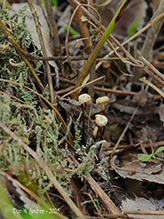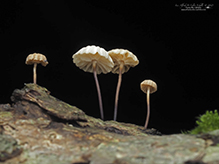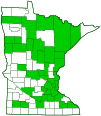Collared Parachute
(Marasmius rotula)
Conservation • Description • Habitat • Ecology • Distribution • Taxonomy
Conservation Status |
|||
| IUCN Red List | not listed |
||
| NatureServe | NNR - Unranked |
||
| Minnesota | not listed |
||
Description |
Collared Parachute is a very common, tiny to small, pinwheel mushroom. It is sometimes called Pinwheel Mushroom, but that common name also applies to the fungus family Marasmiaceae to which it belongs. It occurs in Europe and North America. In the United States and southern Canada, it occurs east of the Great Plains and in the Pacific Northwest. Collared Parachute is found from spring through fall, alone, in groups, or clustered, in deciduous and mixed forests and woodlands, in thickets, and around shade trees. It is especially abundant after rain. It grows on fallen twigs, branches, and woody debris of hardwoods, rarely on coniferous wood. It does not grow on fallen leaves. It gains its nutrients from decaying wood (saprobic). In dry weather, the collared parachute mushrooms shrivel into a dried, almost invisible state. However, with the first drop of rain, they spring back to life, regaining their full size and shape. This "resurrection" ability often misleads people into thinking that new mushrooms have suddenly appeared, when in fact, they've been there all along, patiently waiting for the moisture they need to rehydrate. The cap is white or whitish, it has a central depression, and it is deeply, radially pleated, parachute-like. This is the feature that gives the species the second part of its common name. It can be ⅛″ to ¼″ (4 to 20 mm) wide, but it is usually no more than ⅜″ (10 mm) wide. It is broadly convex at first, but at maturity, when viewed from the side, it appears flat with squarish sides. The surface is hairless and dry. The gills are white or whitish and they are very widely spaced. They are not attached to the stem but to a tiny collar that encircles the stem. This is the feature that gives the species the first part of its common name. The stalk is wiry, hollow, 1⁄16″ to 5⁄16″ (1.5 to 8.0 cm) long, and 1⁄32″ to 1⁄16″ (1 to 2 mm) thick. It is pale at first, but it soon turns mostly dark brown to black, remaining pale just at the top. There are sometimes stiff hairs at the base. The flesh is thin. Edibility is unknown, but it is too tiny to be of value, and it sometimes leaves a bitter aftertaste. The spore print is white or whitish. |
Similar Species |
Fungus (Marasmius capillaris) is very similar but it grows of decaying leaves, not decaying wood. |
Habitat and Hosts |
|
Ecology |
Season |
|
Distribution |
||
|
Sources Biodiversity occurrence data published by: Minnesota Biodiversity Atlas (accessed through the Minnesota Biodiversity Atlas Portal, bellatlas.umn.edu, 9/18/2025). |
|
| 9/18/2025 | ||
Occurrence |
||
Very common |
||
Taxonomy |
|
Kingdom |
Fungi (Fungi) |
Subkingdom |
Dikarya |
Phylum |
Basidiomycota (Basidiomycete Fungi) |
Subphylum |
Agaricomycotina (Higher Basidiomycetes) |
Class |
Agaricomycetes (Mushrooms, Bracket Fungi, Puffballs, and Allies) |
Subclass |
Agaricomycetidae |
Order |
|
Suborder |
Marasmiineae |
Family |
Marasmiaceae (pinwheel) |
Subfamily |
Marasmieae |
Genus |
Marasmius (pinwheels and parachute mushrooms) |
Subgenus |
Marasmius |
Section |
Marasmius |
Subsection |
Marasmius |
Subordinate Taxa |
|
|
|
Synonyms |
|
Agaricus rotula Agaricus rotula var. concolor Agaricus rotula var. mesophaeus Androsaceus rotula Chamaeceras rotula Hypophyllum rotula Marasmius rotula var. fuscus Marasmius rotula var. microcephalus Marasmius rotula var. phyllophila Merulius collariatus Micromphale collariatum Omphalia rotula |
|
Common Names |
|
Collared Parachute Pinwheel Mushroom |
|
Glossary
Saprobic
A term often used for saprotrophic fungi. Referring to fungi that obtain their nutrients from decayed organic matter.
Visitor Photos
Share your photo of this fungus.
This button not working for you?
Simply email us at info@MinnesotaSeasons.com.
Attach one or more photos and, if you like, a caption.
Dan W. Andree |
||
 |
 |
|
Collard Parachute Mushrooms and Dragon Horn Lichen... I went back out … and noticed two very tiny collared mushrooms you can see just below and off to the left of my thumb in the photo as well as some bigger ones to the right in the photo. One article I read on collared parachute mushrooms is after a rain they can perk right back up and I guess lichens benefit too from rain. Rain is expected over the next 2-3 days. If I get back out near that area I’ll check and see if there is a change. Been warm and dry in this area recently. |
||
Alfredo Colon |
 |
MinnesotaSeasons.com Photos
|

Slideshows
Marasmius rotula
Andrée Reno Sanborn
Marasmius rotula
Mushrooms Fungi

Visitor Videos
Share your video of this fungus.
This button not working for you?
Simply email us at info@MinnesotaSeasons.com.
Attach a video, a YouTube link, or a cloud storage link.
Other Videos
Pinwheel Mushroom, Tiny Fairy Mushrooms growing on twigs. Really pretty Nature. Marasmius rotula
Wheelers Way

Visitor Sightings
Report a sighting of this fungus.
This button not working for you?
Simply email us at info@MinnesotaSeasons.com.
Be sure to include a location.
Dan W. Andree
9/17/2025
Location: Norman Co. Mn.
I went back out … and noticed two very tiny collared mushrooms you can see just below and off to the left of my thumb in the photo as well as some bigger ones to the right in the photo. One article I read on collared parachute mushrooms is after a rain they can perk right back up and I guess lichens benefit too from rain. Rain is expected over the next 2-3 days. If I get back out near that area I’ll check and see if there is a change. Been warm and dry in this area recently.
MinnesotaSeasons.com Sightings |
|




